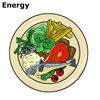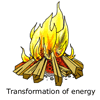Transformation of solar energy
 You
have already discovered that energy cannot be created or destroyed.
Where does energy come from? The answer is that on Earth the primary
source of energy is the Sun. The Sun is an enormous nuclear reactor
producing energy by destroying matter in a process called nuclear
fusion. In this process, hydrogen atoms are fused or joined to make
larger atoms and the energy produced is radiated into the Universe
as electromagnetic radiation. The Earth, being close to the Sun, receives
a small portion of this radiated energy.
You
have already discovered that energy cannot be created or destroyed.
Where does energy come from? The answer is that on Earth the primary
source of energy is the Sun. The Sun is an enormous nuclear reactor
producing energy by destroying matter in a process called nuclear
fusion. In this process, hydrogen atoms are fused or joined to make
larger atoms and the energy produced is radiated into the Universe
as electromagnetic radiation. The Earth, being close to the Sun, receives
a small portion of this radiated energy.
Energy from the
Sun - solar energy
The solar energy arrives at the Earth's atmosphere ranging from radio
waves through visible to gamma radiation. (See Electromagnetic spectrum
for more information) It is this solar energy that is transformed
into the range of energies we rely on here on the Earth. Without the
Sun, we would soon be a dead planet.
Solar power to electricity
|
|
 With
solar cells it is possible to transform the Sun's energy into With
solar cells it is possible to transform the Sun's energy into electrical energy. This is particularly valuable where other
sources of electrical energy are not available, for example,
a telephone box way out in the bush. Solar cell generated electrical
energy can also be transformed to kinetic energy, as is done
with solar powered cars.
electrical energy. This is particularly valuable where other
sources of electrical energy are not available, for example,
a telephone box way out in the bush. Solar cell generated electrical
energy can also be transformed to kinetic energy, as is done
with solar powered cars.
A more common use of energy from the Sun is to generate electrical
energy by water flowing from lakes or dams. In this case, there
is a chain of transformations. First, the Sun's energy evaporates
water from the ocean or lakes. This water vapour rises, gaining
gravitational potential energy. Clouds form and the falling
rain experiences the transformation of potential to kinetic energy. Water collected in dams above sea level still
has gravitational potential energy. Water flowing down from
the dam through a generator, transforms the stored gravitational
potential energy of the water, into kinetic energy of the moving
turbine blades in the generator, which is, in turn, transformed
into electrical energy. It is a long chain, all begun by the
Sun.
kinetic energy. Water collected in dams above sea level still
has gravitational potential energy. Water flowing down from
the dam through a generator, transforms the stored gravitational
potential energy of the water, into kinetic energy of the moving
turbine blades in the generator, which is, in turn, transformed
into electrical energy. It is a long chain, all begun by the
Sun.
|
|
Food energy
 We all need food to maintain life. The energy in food is chemical
energy which is transformed into thermal energy to keep us warm, to
drive our internal functions and, with children, to grow. Plants use
energy from the Sun's combined with carbon dioxide and water to produce
food by a process called photosynthesis. Plants are chemical factories
storing energy in the form of sugars so that it can be transformed
at a later time.
We all need food to maintain life. The energy in food is chemical
energy which is transformed into thermal energy to keep us warm, to
drive our internal functions and, with children, to grow. Plants use
energy from the Sun's combined with carbon dioxide and water to produce
food by a process called photosynthesis. Plants are chemical factories
storing energy in the form of sugars so that it can be transformed
at a later time.

Stored
energy from the past
Energy from food keeps us warm inside and helps maintain our bodies,
but we also need an external source of storable energy to run our
machines and make our lives more comfortable. This energy can come
from plants too, but in a slightly different way. A wood fire burns
plant material, largely from trees that have stored solar energy over
many years. Coal is even older and is the compressed remains of plants
millions of years old. When we burn coal we are using the Sun's energy.
Oil is thought to have come from tiny sea creatures, their gathered
energy trapped for millions of years under the ground in the form
of crude oil and natural gas. This stored energy is transformed by
machines into light, thermal energy, kinetic energy and electrical
energy to carry the transformation chain even further.